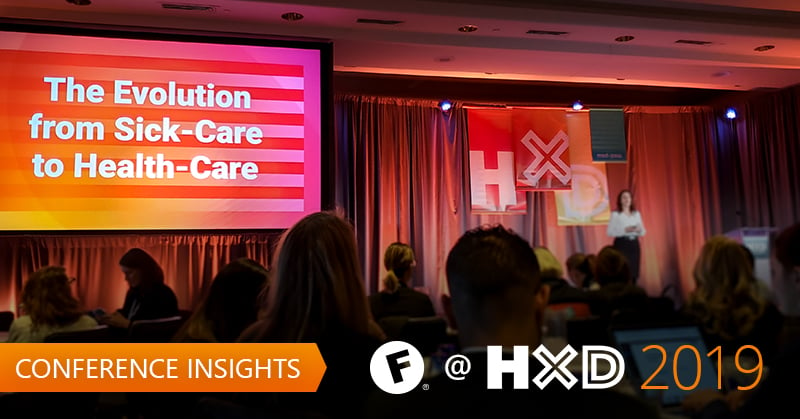Seven members of Farm's Design & Strategy team joined 400 other thought leaders in design, innovation, research, strategy, and technology at the 9th annual Health Experience Design conference that took place in Boston April 2-3rd. The presenting speakers had varied backgrounds that included medical, academia, design and technology. The presentations and workshops inspired robust thought and exciting discussion among our team. While many of the topics were not strictly related to product design and development, ALL of them sparked useful insights that apply directly to our work. We are already starting to apply what we learned.
The conference covered a wide range of subject matter from across the healthcare domain. Here are some of the key takeaways:
 Jim Best - Principal Industrial Designer
Jim Best - Principal Industrial Designer
Aside from crafting how things look, feel, and work, design is fundamentally about communication. And if communication is fashioned to effectively resonate with its audience, it has the potential to have a profound impact on how that audience interacts and experiences the world. Understanding ‘behavior change’, the theme of this years’ HXD conference, shined a spotlight on how the application of social science methods can help us better understand how people "work", and as a result, optimize how to shape communication to enable design to be an effective influencer. Influencing behavior is among the most important benefits design can deliver in healthcare. It can reduce errors, increase caregivers’ performance, help patients adhere to therapies, and improve the likelihood of healthier outcomes. The HXD presenters wove in convincing examples of how the use of behavioral science models and evidence-based practices can lead to these positive results, as well as inform how to best frame problems, unwind systemic challenges, and navigate resistance to allow a better way to take hold. Creativity and stakeholder accounts are not enough if we want to overcome the power struggles preventing change and making the best ideas go. Getting to the root cause of what motivates engagement, shapes attitudes, impacts mindsets and harmoniously interlaces with culture were the principal ‘TO DO’s’ echoed over this two-day event.
 Heather Gass - Senior User Interface Designer
Heather Gass - Senior User Interface Designer
Jenka Gurfinkel, from athenahealth, gave a great talk on shifting our design values away from persuasion-based values of desirability and delight to health-centered values focused on design responsibility, pain reduction, empowerment, and dignity. As designers in healthcare, we can use these values to reframe the conversations we have about design and user experience. We can question if usefulness is coming at the cost of pushing pain onto users. We can evaluate how our products are affecting people beyond their intended use and work to prevent unfortunate consequences. And we can infuse dignity into our products by accounting for all use cases, not only the ideal ones. When our pinnacle of UX maturity shifts from delight to dignity, we can make better choices that improve our user's physical, emotional, and social health. And isn't that what we really want from our work in healthcare?
 Chris Labak - Principal Designer
Chris Labak - Principal Designer
One of the main themes of this year’s conference was a better understanding of the patient experience and how to apply the basic principles of treating others as you would like to be treated. It seems simple, but it was a great reminder for any of us involved in the design process. This applies whether it involves conducting primary research, developing a digital interface, or creating a physical product. Being more empathetic to the needs of the user, and understanding their environment and context of use, can provide a better experience for any type of product. Host Amy Heymans (Cueva) talked about purpose-driven design and how "compassion equals empathy in action."
Several speakers touched on this theme, such as Jennifer Smerdel, a service designer at the Mayo Clinic. She spoke about how hospitals often use surveys to gather longitudinal data from patients to help improve their healthcare experience over their lifetime. Unfortunately, sometimes these questionnaires are requested at inappropriate times, such as immediately following a brain cancer diagnosis. When surveys are requested during a period of high emotions, the data collected may be skewed, so it might not provide the same valuable information the agency is seeking. For effectiveness, institutions need to make sure this material is being collected and used appropriately to improve patient care. For example, if a patient reports they are not doing well, will a doctor contact them directly to discuss?
An alternative solution to improving healthcare experiences is the increased use of wearable tracking devices. These devices assist by measuring health indicators, like the heart rate of a cardiac patient, and automatically transmitting the data to the doctor. By using these devices, the burden on patients to track this information separately is reduced. Technology can’t solve everything, but a simple device like this can help bridge the gap and reduce the burden on patients. In this way, patients can go on living their lives, which is what any of us, in the end, really want to do.
 Erin-Anne Lemieux - Principal Designer
Erin-Anne Lemieux - Principal Designer
I noticed two themes that weren’t the sole focus of any one presentation, but that seemed to carry across many of the presentations we saw at HXD this year. The first is that there is a shift in the healthcare space, where people are moving from being simply patients, to being consumers of healthcare, and this is where the patient experience becomes so important. With the rise of immediate care facilities, and hospital affiliated medical practices, healthcare “customers” now have choices when it comes to where they bring their healthcare business. Since cost is still not transparent, patients will evaluate a facility’s services based on their experience and choose to frequent those facilities that provide better experiences. A health center’s brand value is now directly related to consumer perception, and that will lead to opportunities for improvements in the healthcare experience, through the design of the products and services of our clients.
The second theme that emerged is the power of human connection. Several speakers discussed the impact of loneliness on the health of our aging population, we heard about the role of social dynamics on behavior change and were encouraged to build social connection into our designs. Taken further, we were reminded, through the many shared personal experiences, that patient stories resonate, and help us to build that human connection that is so fundamental to a healthy life.
 Dan O'Sullivan - Director, Design & Strategy
Dan O'Sullivan - Director, Design & Strategy
As a society, we are less healthy than we have ever been, and the trend is only intensifying. At the HXD conference, Steve Downs presented “Designing everyday life to be healthier” which highlighted the shocking statistics of how the cost of health care for Americans continues to rise as our life expectancy heads in the opposite direction. On a list of 60 countries ranked for age-related disease burden, the US was near the bottom of the list at number 53. There is plenty of focus on the need to improve the healthcare system, deliver better medicine, and improve patient outcomes. That’s all good, but the point is that we should be focusing on how to be healthier in the first place. It’s probably no surprise that we need more sleep, more exercise, and healthier food. Then what are the hurdles in our way? Steven pointed out how companies like Hello Fresh have a goal of making a difference to customers’ lives by creating an experience that enables them to live better and healthier while embracing the fun of home cooking. We need to find ways to make it easier to be healthy by reducing the barriers, providing options, and making it at least as easy to be healthy as it is to be unhealthy, which would be a major improvement from where we are today. As designers, we have the ability, and the responsibility, to design products and experiences that guide users to make healthy decisions. For example, the designer of a GPS app wanting to emphasize health might choose walking directions as a default (if a reasonable distance). What will we design next to put the focus on health care rather than sick care? What will it take for the US to be #1? I’m not sure I know the answer but I plan to go for a walk to think about it.
 Chris Thurrott - Principal User Interface Designer
Chris Thurrott - Principal User Interface Designer
One of my "a-ha" moments was listening to the Thinkwell Group presentation drawing parallels between designing experiences for theme parks and for healthcare environments. Both require management of consistent delivery of service, transitions between physical spaces and states of being, preparing for common deviations from the structured experience, and acknowledging the human factors for both patients and the professionals who are providing their care.
For example, theme parks know they will have long wait times, so they build in affordances for guests to rest. They understand that ride experiences can be disorienting so they give guests a place to recover and come back to center. We can use these principles as a lens for our work at Farm, both within digital interfaces and in thinking about how the use of products we design fits into the overall context of use.
 Jim Tirone - Senior Industrial Designer
Jim Tirone - Senior Industrial Designer
As designers with the best of intentions, we spend countless hours perfecting our products for the masses. Often overlooked is the disparity of access to our products and services once they are out in the world. Kevin Dedner of Henry Health gave a heartfelt presentation on accessing our most vulnerable patients and providing health services to black males. This is a demographic that has been horribly underserved, and location is one of the contributing factors. The idea that a zip code can be a social determinant of long-term health is not necessarily a surprising revelation, but it is a reminder to us all that while the world has become a bit smaller thanks to technology, access to services is not always equal. The discussion of designing for equity versus equality became a common theme touched on by many of the presenters.
So, as Mr. Dedner and Henry Health strive for their “moonshot” of adding 10 years to the life expectancy of black men over the next twenty-five years; as designers, lets aim to be more inclusive and keep this in mind as we develop products. We must make sure to include the most vulnerable people in the conversations about health and ensure that our products provide them with equitable opportunities for good health.
